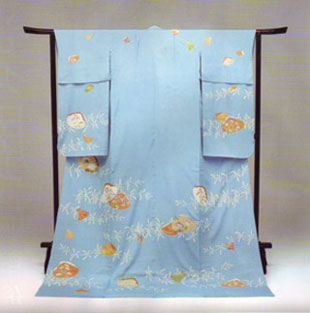Recently my friend and ikebana mentor Kazuko Nishikawa was invited to arrange flowers for an exhibition of maiko kimono at the Some Museum (Museum of Dyed Textiles).  Maiko are apprentice geisha and their elaborate kimono are much more ornate and theatrical than those worn by the average Japanese woman. As befitting a young woman, the kimono are furisode style with long sleeves. And as shown at the picture at bottom, the obi also has long trailing ends instead of the more common flat square knot worn by married women.
Maiko are apprentice geisha and their elaborate kimono are much more ornate and theatrical than those worn by the average Japanese woman. As befitting a young woman, the kimono are furisode style with long sleeves. And as shown at the picture at bottom, the obi also has long trailing ends instead of the more common flat square knot worn by married women.
Since maiko are apprentices and have not yet developed the range of social skills
 exercised by fully trained geisha, their duties mostly involve music and dance performances, which accounts for the colorful theatrical style of their kimono.
exercised by fully trained geisha, their duties mostly involve music and dance performances, which accounts for the colorful theatrical style of their kimono.
 Maiko kimono are of course frequently decorated with brightly colored flowers and butterflies, but literary motifs are also common as are symbols of a traditional lifestyle. The blue kimono above features decorated clam shells, representing the kai awase game that was popular during the Heian era in the 11th century. Similar to the card game “Concentration”, the game used sets of clamshells rather than cards. Matching scenes were painted on the interior surfaces of each pair of shells, while the exterior surfaces were polished to a smooth blank, making hard to recognize which pairs would go together when all of the clamshells were placed with the painted side down. Some of the older sets contained as many as 360 pairs of shells, though simplified sets of 54 pairs based on scenes from Tale of Genji later became popular.
Maiko kimono are of course frequently decorated with brightly colored flowers and butterflies, but literary motifs are also common as are symbols of a traditional lifestyle. The blue kimono above features decorated clam shells, representing the kai awase game that was popular during the Heian era in the 11th century. Similar to the card game “Concentration”, the game used sets of clamshells rather than cards. Matching scenes were painted on the interior surfaces of each pair of shells, while the exterior surfaces were polished to a smooth blank, making hard to recognize which pairs would go together when all of the clamshells were placed with the painted side down. Some of the older sets contained as many as 360 pairs of shells, though simplified sets of 54 pairs based on scenes from Tale of Genji later became popular.
There are about 100 to 150 maiko in Kyoto. Most live and work in the Gion or Ponto-cho areas on the east side of town. They are considered professional entertainers and tourists flock to the area to glimpse a “geisha”, just as Hollywood tourists might hope to see a movie star. Maiko dance movements are highly stylized and use the long flowing sleeves to add a graceful flutter. The dance often represents a poem or enacts a literary scene. Click here to view a brief performance.





 On the far right are my friends, Kiyomi Yatsuhashi and
On the far right are my friends, Kiyomi Yatsuhashi and 





